Bryan L. Programmable controllers. Theory and implementation
Подождите немного. Документ загружается.

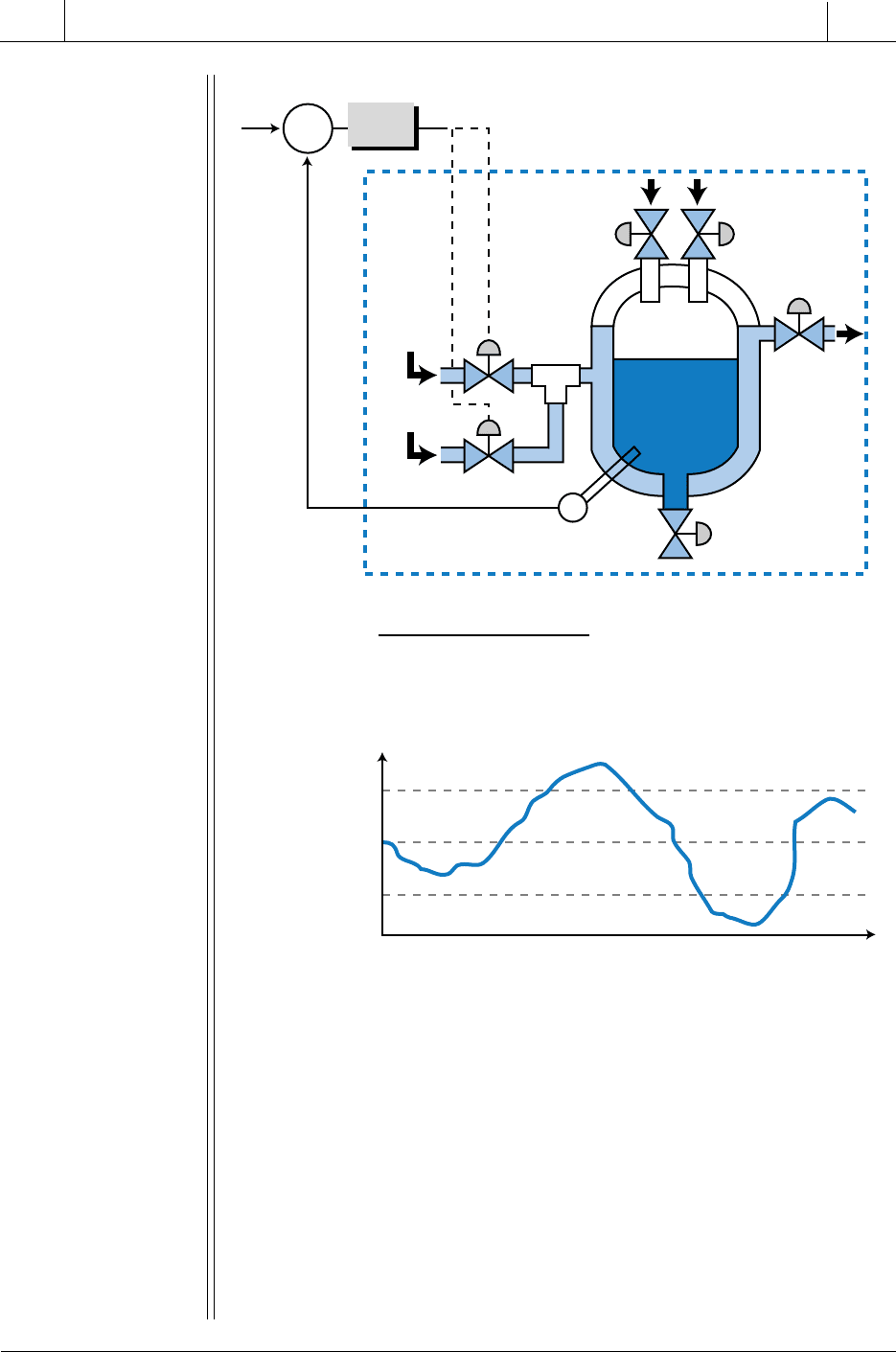
689
CHAPTER
15
Process Controllers
and Loop Tuning
SECTION
4
PLC Process
Applications
Industrial Text & Video Company 1-800-752-8398
www.industrialtext.com
Figure 15-21. Steam heating system controlled by a three-position controller.
V2 V1 Steam
OFF
OFF
ON
OFF
ON
ON
0%
50%
100%
PV
= 210°F
(
E
= +10)
PV
=
SP
= 200°F
(
E
= 0)
PV
= 190°F
(
E
= –10)
PV
t
PV
SP
+
–
Σ
Temperature
Sensor
Steam
Return
Material 1
Material 2
Hc
Steam 1
Steam 2
V1
V2
Hp
CV
SOLUTION
Figure 15-22 shows the controller output (
CV
) for this three-position
discrete-mode controller. Note that the response plot (see Figure 15-
22a) shows that an overshoot is present, indicating a lag in steam
actuation. The same lag also creates an undershoot condition when
both V1 and V2 are ON. As shown, the system overshoot and
undershoot pass the deadband during the lag periods.

690
SECTION
4
PLC Process
Applications
Industrial Text & Video Company 1-800-752-8398
www.industrialtext.com
CHAPTER
15
Process Controllers
and Loop Tuning
Figure 15-22. (a) Response plot and (b) controller output of the heating system in
Figure 15-21.
15-4 CONTINUOUS-MODE CONTROLLERS
Most process control applications employ continuous-mode controllers,
instead of discrete-mode controllers, to avoid the oscillatory system response
caused by ON/OFF control. A continuous-mode controller sends an analog
signal to the process control field device (see Figure 15-23) to regulate the
process variable, bringing the error signal to zero in a closed-loop system. A
continuous-mode controller behaves like a multiposition controller with an
infinite number of positions. In a PLC-based system, the controller may be an
intelligent I/O interface or software routine instructions that use standard I/O
analog modules.
Continuous-mode controllers use three different modes to control the process:
• proportional control mode
• integral control mode
• derivative control mode
These three modes are also referred to as controller actions, each one reacting
differently to the error present in the system in a direct- or reverse-acting
fashion. The proportional mode provides a control variable adjustment that
is proportional to the error deviation. The integral mode (or reset mode)
provides a change in the control variable based on the time history of the error.
The derivative mode (or rate mode) provides a change in the control variable
based on the rate of change of the error signal. The combination of all three
V2 V1
100%
50%
0%
ON
ON
OFF
ON
OFF
OFF
CV
Lag
Lag
Lag
Lag
PV
= 210°F
(
E
= +10)
PV
=
SP
= 200°F
(
E
= 0)
PV
= 190°F
(
E
= –10)
PV
t
t
(a)
(b)

691
CHAPTER
15
Process Controllers
and Loop Tuning
SECTION
4
PLC Process
Applications
Industrial Text & Video Company 1-800-752-8398
www.industrialtext.com
Figure 15-23. Block diagram of a continuous-mode controller.
modes in one controller forms the industry standard known as PID control.
Table 15-1 shows the different possible combinations of continuous control-
ler modes. Note that the derivative action is not used as a stand-alone mode
Table 15-1. Continuous controller modes.
Hc
E = SP – PV CV
0–10 VDC
PV
SP
+
–
Σ
Steam
Temperature
sensor to PLC’s input
for feedback
0%–100%
Steam Flow
Analog Signal
Hp
rellortnoC
edoM
esnopseRsnoitacilppA
lanoitroporPP
VC
nisegnahc
otnoitroporp
E
daolllamshtiwsmetsyS
otllamsro/dnasegnahc
semitgaletaredom
largetnII
VC
gnidroccasegnahc
wohot
E
revosegnahc
emit
llamshtiwsessecorP
llamsdnasgalssecorp
seiticapac
evitavireDD
VC
gnidroccasegnahc
tsafwohot
E
segnahc
nienoladesutoN
snoitacilppa
largetnI-lanoitroporPIP
VC
anisdnopser
IdnaPfonoitanibmoc
snoitca
daolegralhtiwsmetsyS
segnahc
-lanoitroporP
evitavireD
DP
VC
anisdnopser
DdnaPfonoitanibmoc
snoitca
tsafhtiwsessecorP
segnahcdaol
-lanoitroporP
evitavireD-largetnI
DIP
VC
anisdnopser
,I,Pfonoitanibmoc
snoitcaDdna
nidesuebnaC
ssecorpllayllacitcarp
snoitacilppalortnoc
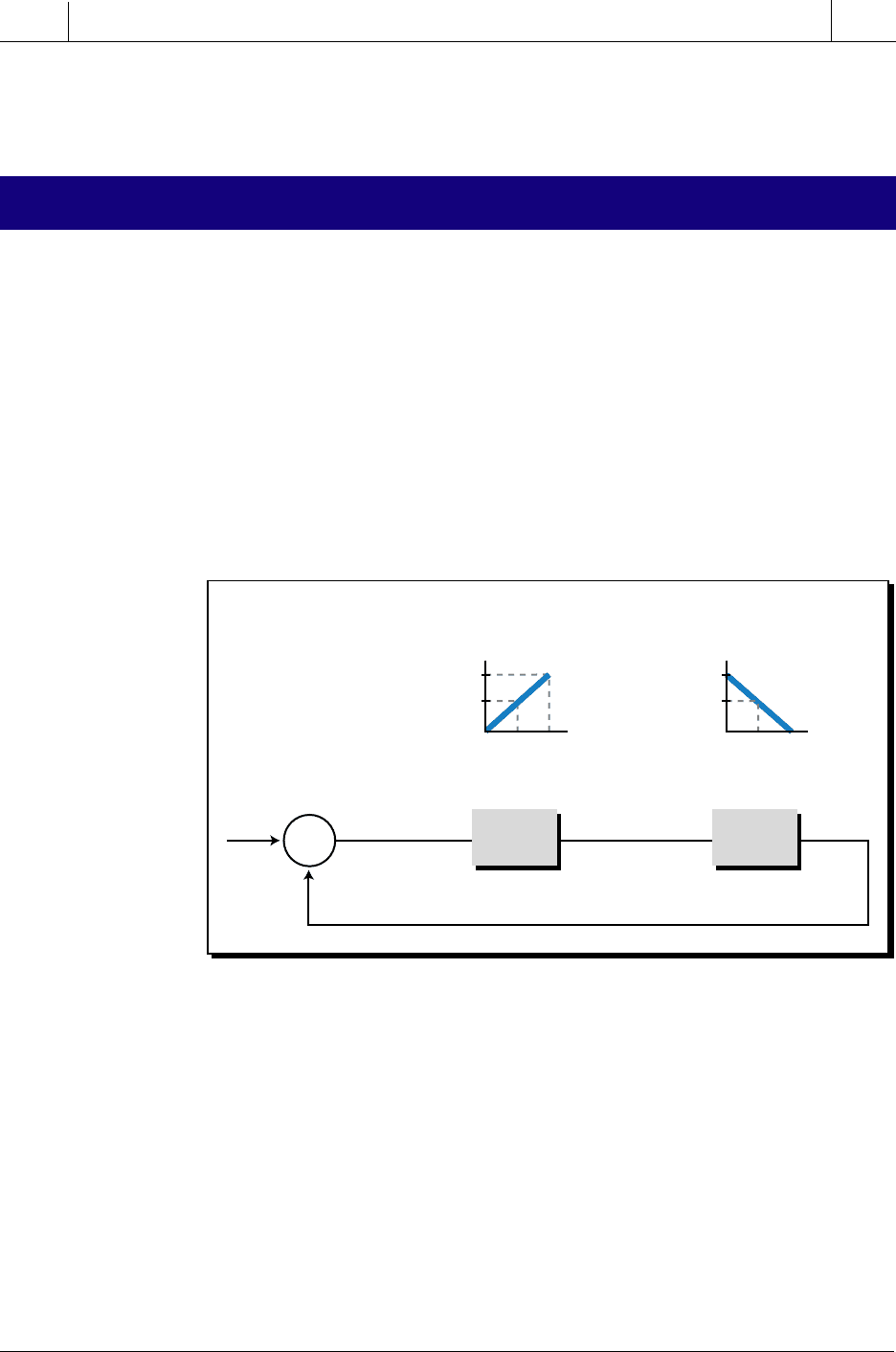
692
SECTION
4
PLC Process
Applications
Industrial Text & Video Company 1-800-752-8398
www.industrialtext.com
CHAPTER
15
Process Controllers
and Loop Tuning
in applications. This is due to the derivative action’s response, which
produces a high output but only for a short period of time. This has little effect
on the process and, consequently, does not provide any process control.
Figure 15-24. Proportional closed-loop control.
15-5 PROPORTIONAL CONTROLLERS (P MODE)
A proportional controller adjusts the control variable output in a manner
proportional to the error. As shown in Figure 15-24, the controller (Hc)
receives feedback information from the process (Hp) in the form of the
process variable, which is then compared to the set point. The error created,
either positive or negative, tells the controller what percentage of output (CV)
to provide to bring the error to zero. Figure 15-25 illustrates a typical
proportional controller transfer function for a direct-acting controller (e.g., a
cooling system). As the error becomes more negative (PV > SP), the controller
will increase the control variable in proportion to the error. This will cause the
process variable (from Hp) to decrease, thus pushing the error to zero. If the
error becomes more positive, the opposite occurs.
The control variable output (CV
(t)
) of a proportional controller, starting from
the set point value, is expressed by:
CV K E CV
tP E() ( )
=+
=0
where:
K
E
CV
P
E
=
=
=
=
the proportional gain of the controller
the current error
the controller output when the error equals 0
()0
100%
50%
0%
–0+
E
(%)
E
(%)
CV
100%
50%
0%
–0+
CV
HpHc
CV PVSP E = SP – PV
+
–
Σ
Direct
Acting
Controller
Action
Process
Reaction
Process
P mode
PV
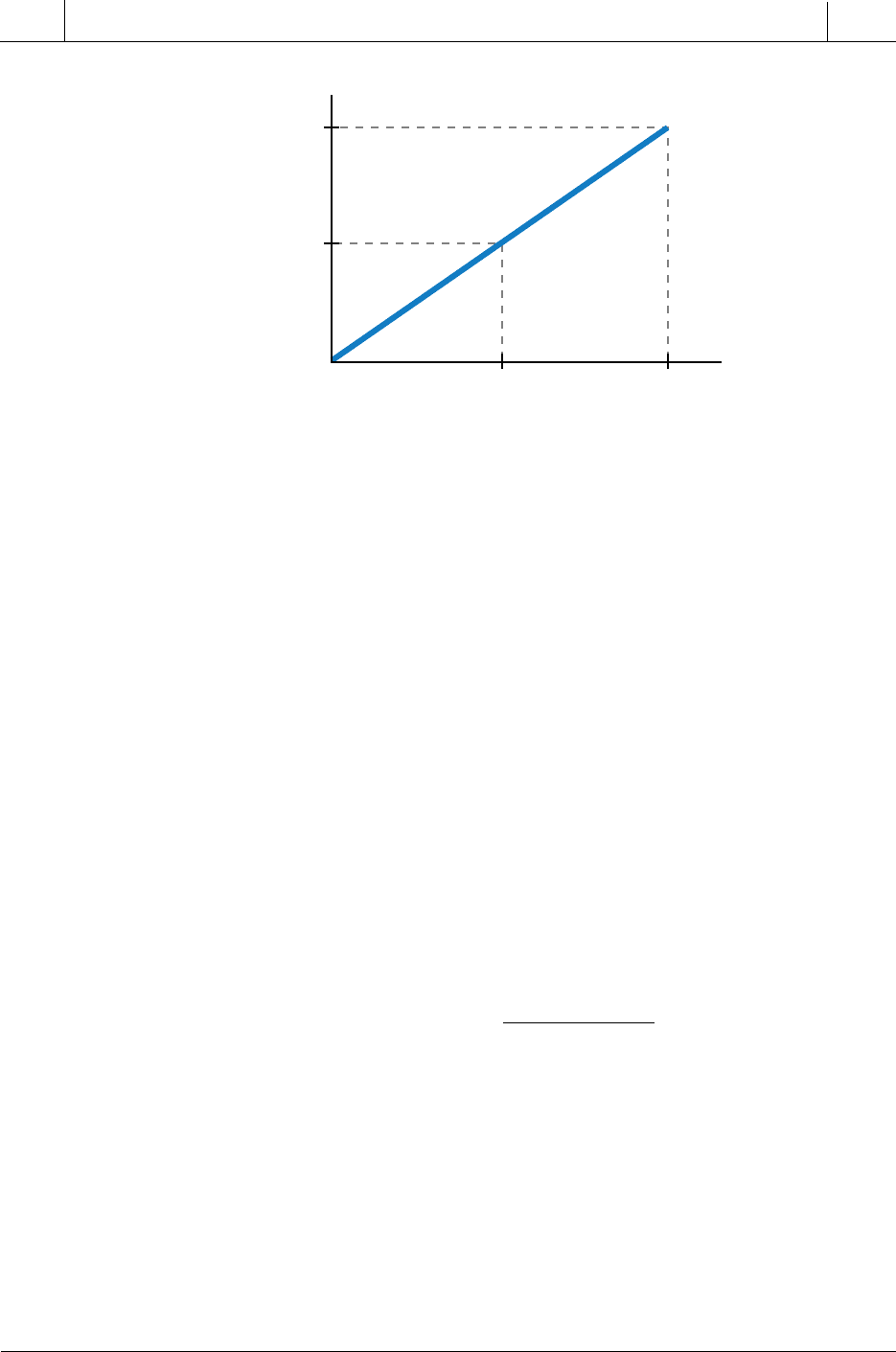
693
CHAPTER
15
Process Controllers
and Loop Tuning
SECTION
4
PLC Process
Applications
Industrial Text & Video Company 1-800-752-8398
www.industrialtext.com
Using this equation, a proportional controller can adjust the value of the
control variable according to time and error by replacing the CV
(E=0)
term with
the previous value of CV:
CV K E CV
Pnew old
=+
So, if a controller with a control variable output value of 50% senses that the
proportional error in the system (K
P
E) is 20%, its new output will be 70%:
CV
new
=+
=
20 50
70
%%
%
This value indicates a linear correspondence between the control variable
and the error, as was depicted in the graph in Figure 15-25. This graphic
representation is called the proportional band, and it shows the error values
associated with the full range of the controller output. The slope of this graph,
the proportional gain K
P
, is computed by dividing the percentage change in
output by the percentage change in error:
K
CV
E
P
=
% change in
% change in
The proportional gain, therefore, is expressed in units of %/%. For example,
a gain of 1 indicates that a 1% change in error will cause a 1% change in
controller output. Note that the direction of the slope of the proportional gain
(the positive or negative response of the control variable to a change in the
error) depends on whether the controller is direct acting or reverse acting.
The proportional gain relationship between the error and the control variable
depends on the width of the band upon which the controller is acting. For
example, the temperature control system in Figure 15-26 has a temperature
Figure 15-25. Direct-acting proportional controller transfer function.
100%
50%
0%
PV
<
SP PV
>
SPE
= 0
SP
=
PV
E
=
SP – P
V
CV

694
SECTION
4
PLC Process
Applications
Industrial Text & Video Company 1-800-752-8398
www.industrialtext.com
CHAPTER
15
Process Controllers
and Loop Tuning
response that spans from 60°F to 180°F, equaling a range of 120°F (180°F –
60°F). However, if the controller only needs to exert control from 90°F to
150°F with the set point at 120°F, it will only be controlling a range of 60°F
(150°F – 90°F) over the total range of 120°F. Therefore, the proportional
band of the controller is 60°F over the 120°F range. Accordingly, the
proportional band (PB) of control as a percentage of the full process variable
range is represented as:
PB
PV PV
PV PV
=
−
−
max min
(max ) (min )range range
Figure 15-26. Proportional band and gain calculations.
100%
50%
0%
CV
PV
60°F90°F 120°F 150°F 180°F
Band of control
where proportional
output is applied
PB
=
PB
= 50%
=
150°F – 90°F
180°F – 60°F
60°F
120°F
K
P
=
100% – 0%
150°F – 90°F
180°F – 60°F
K
P
= = 2%/%
100%
50%
K
P
=
2% change in control output
1% change in error in the band of control
Proportional Band (
PB
)
Gain (
K
P
)
PB
As shown in the calculations in Figure 15-26, the proportional band of the
temperature control system is 50%. The proportional gain of the system is
defined by how much the control variable output changes for each percent of
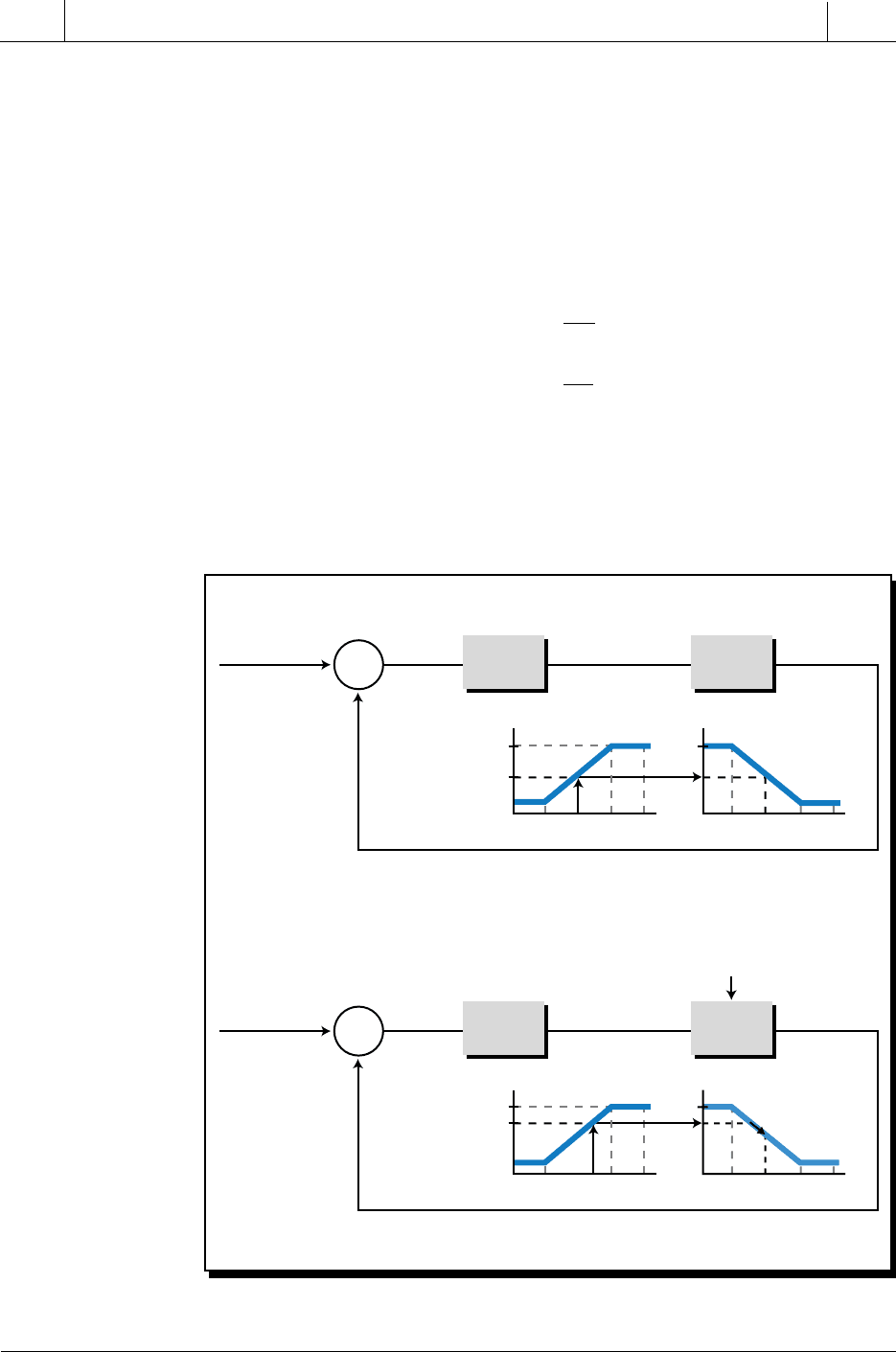
695
CHAPTER
15
Process Controllers
and Loop Tuning
SECTION
4
PLC Process
Applications
Industrial Text & Video Company 1-800-752-8398
www.industrialtext.com
error within the control band. The error percentage range is equal to the
proportional band percentage, because both express how much the process
variable can deviate from the set point. The gain, according to Figure 15-26,
will be 2, meaning that the controller’s output will change 2% for every 1%
change in error. This controller is a direct-acting controller, since the control
variable will change in the same direction (+ or –) as the percentage of error.
Note that the gain and proportional band are inversely related, meaning that:
K
PB
PB
K
P
P
=
=
1
1
If the process variable in the previous example is at the set point of 120%,
then the controller must only maintain CV at 50% to keep the error at 0 (see
Figure 15-27a). However, if the process variable increases to 135°F, the
error incurred over the total temperature span will be:
Figure 15-27. Process with (a) no change and (b) change in
CV
.
HpHc
E
= 0
CV
= 50%
PV
= 120°F
SP
= 120°F
–
+
Σ
100%
50%
0%
60 90 120 150 180
CV
Direct
Acting Process
Process
Response
Proportional
Controller
Action
60
100
90 120 150 180
CV
(a) No change in
CV
keeps the process variable at
SP
.
E
= 12.5
CV
= 75%
PV
= 135°F
SP
= 120°F
–
+
Σ
100%
0%
135°60° 180°
CV
Direct
Acting
Load disturbance
causes
PV
to increase
Process
Response
Proportional
Controller
Action
SP = 120
60° 180°
CV
75%
(b)
CV
increases to force
PV
to the set point
SP
,
bringing the error to zero.
HpHc
°F °F
°F °F
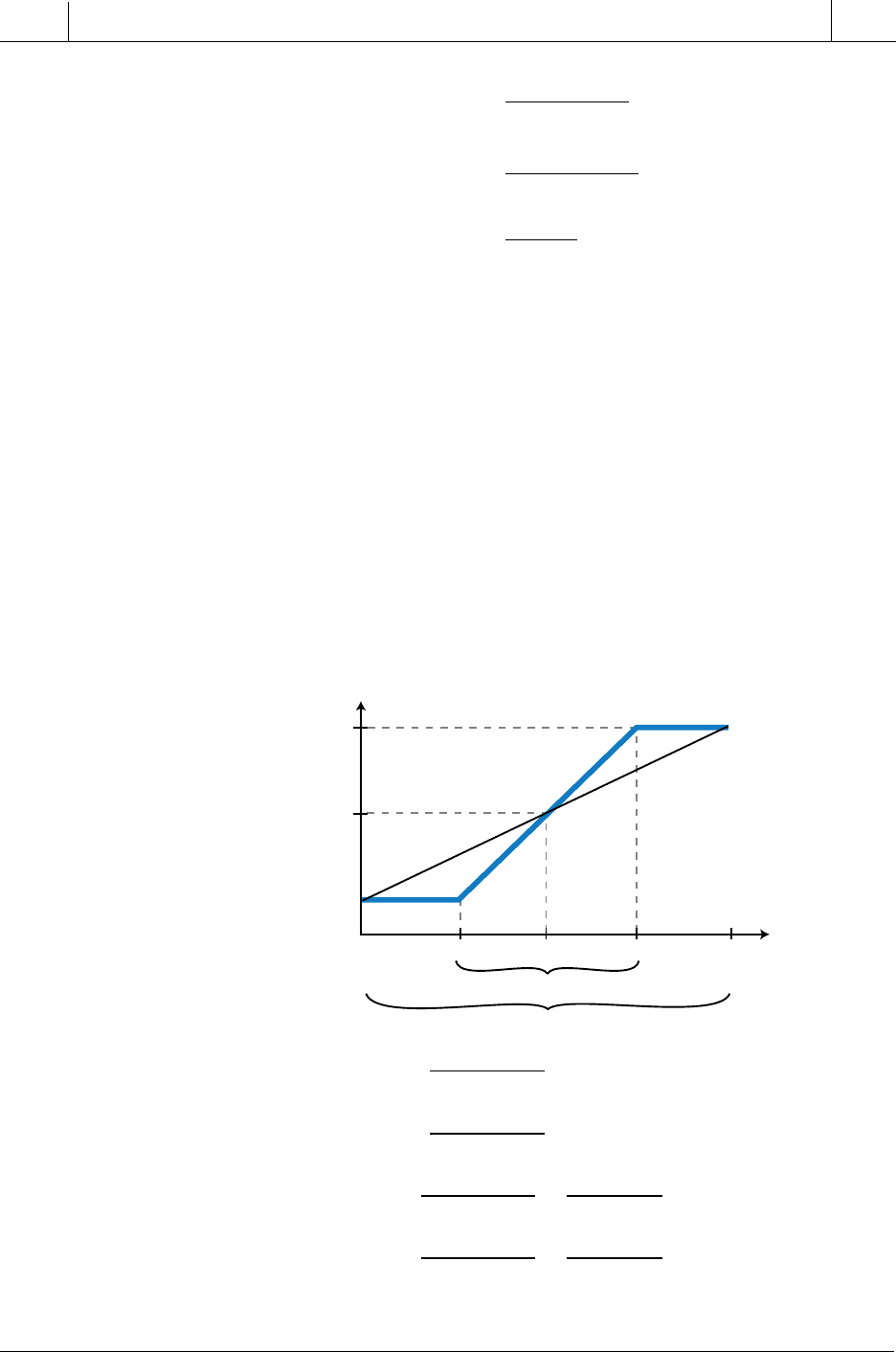
696
SECTION
4
PLC Process
Applications
Industrial Text & Video Company 1-800-752-8398
www.industrialtext.com
CHAPTER
15
Process Controllers
and Loop Tuning
E
SP PV
PV PV
=
−
−
=
°− °
°− °
=
−°
−°
=
min max
.%
120 135
60 180
15
120
12 5
FF
FF
F
F
This error (12.5% above the set point over the PV range) in the controller
equation, as well as in the graphic in Figure 15-27b, indicates that the new
output of the controller will be 75%:
CV K E CV
Pnew old
= 25%+ 50%
= 75%
=+
=
()
()
+2125 50%.% %
The gain of a controller indicates how sensitive the controller is to error. The
proportional band also indicates this sensitivity, since the gain and the band
are related. Figure 15-28 illustrates two controllers with gains of K
P1
= 1 and
Figure 15-28. Two controllers with gains of 1 and 2.
100%
50%
0%
CV
100°F 125°F 150°F 175°F 200°F
PB
1
= 1 = 100% =
200° – 100°
200° – 100°
PB
2
= 0.5 = 50% =
175° – 125°
200° – 100°
K
P
1
= = =
CV
max
–
CV
min
PB
1
K
P
2
= 2 %/% = =
CV
max
–
CV
min
PB
2
100% – 0%
100%
100% – 0%
50%
1 %/%
K
P
2
K
P
2
>
K
P
1
K
P
1
P
V
PB
2
PB
1
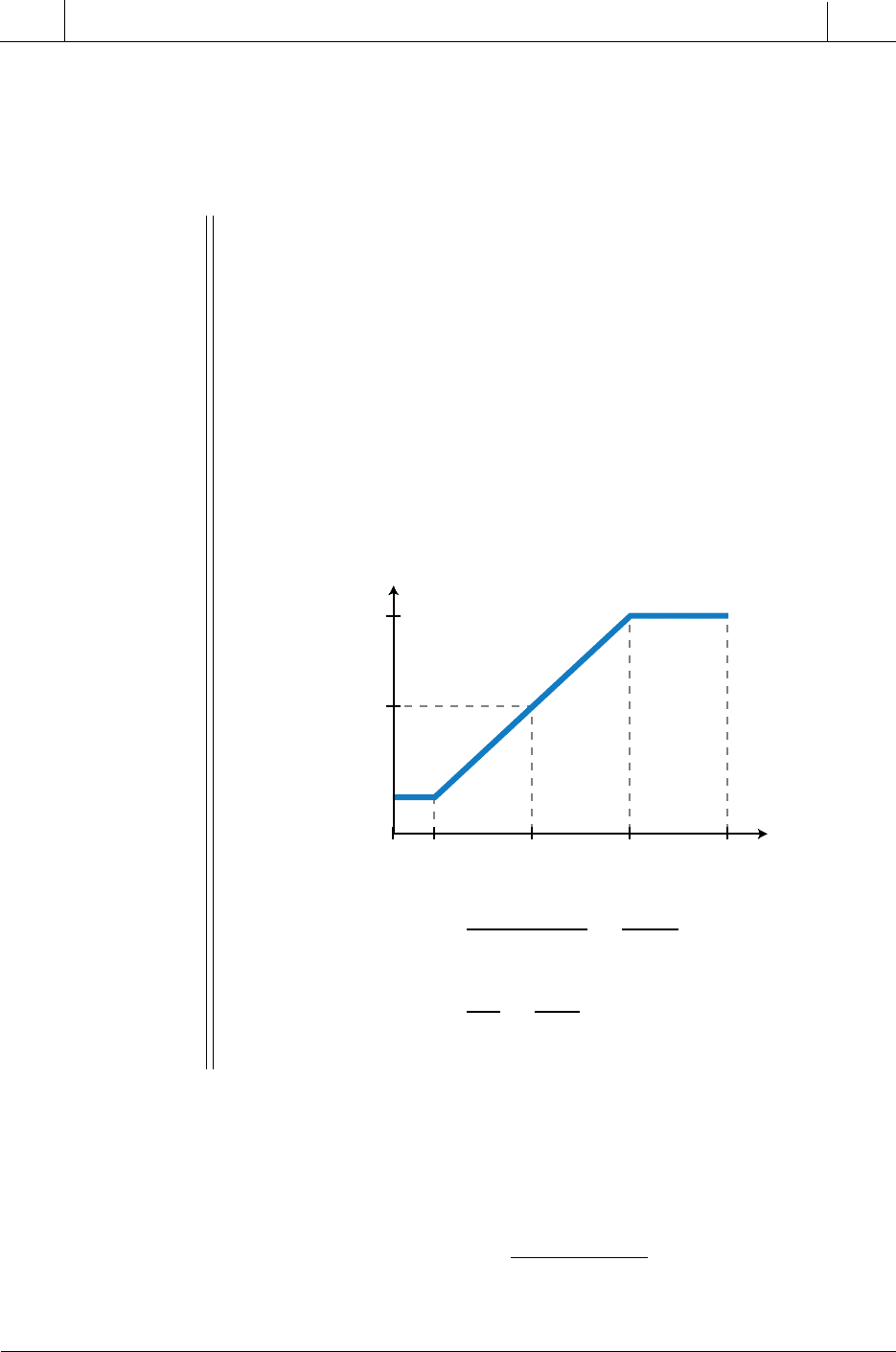
697
CHAPTER
15
Process Controllers
and Loop Tuning
SECTION
4
PLC Process
Applications
Industrial Text & Video Company 1-800-752-8398
www.industrialtext.com
Figure 15-29. Example controller’s transfer function.
The proportional gain for a reverse-acting controller (see Figure 15-30) is
calculated using the same equations as used for a direct-acting one; however,
the sign of the gain will be negative due to the slope of the curve. The
proportional band for the reverse-acting controller in Figure 15-30 is:
PB =
°− °
°− °
=
200 100
200 100
100
FF
FF
%
K
P2
= 2 that have proportional bands of 100% and 50%, respectively. The
system with a gain of 1 will change the controller output 1% for every 1% of
error, while the system with a gain of 2 will have twice the sensitivity,
changing CV 2% for every 1% error.
EXAMPLE 15-4
Graph the transfer function for a proportional controller with a propor-
tional band of 60% over a process variable range of 50°F to 150°F.
The proportional band is centered around a set point of 90°F at a 50%
controller output.
S
OLUTION
Figure 15-29 illustrates the controller’s transfer function. Note that, in
this system, the set point (90°F) is not at the center of the total process
variable range.
100%
50%
0%
CV
50°F60°F
SP
= 90°F 120°F 150°F
PB
= = = 60%
120°F – 60°F
150°F – 50°F
60°F
100°F
K
P
= = = 1.667
1
PB
1
60%
K
P
= 1.667
PB
= 60%
P
V
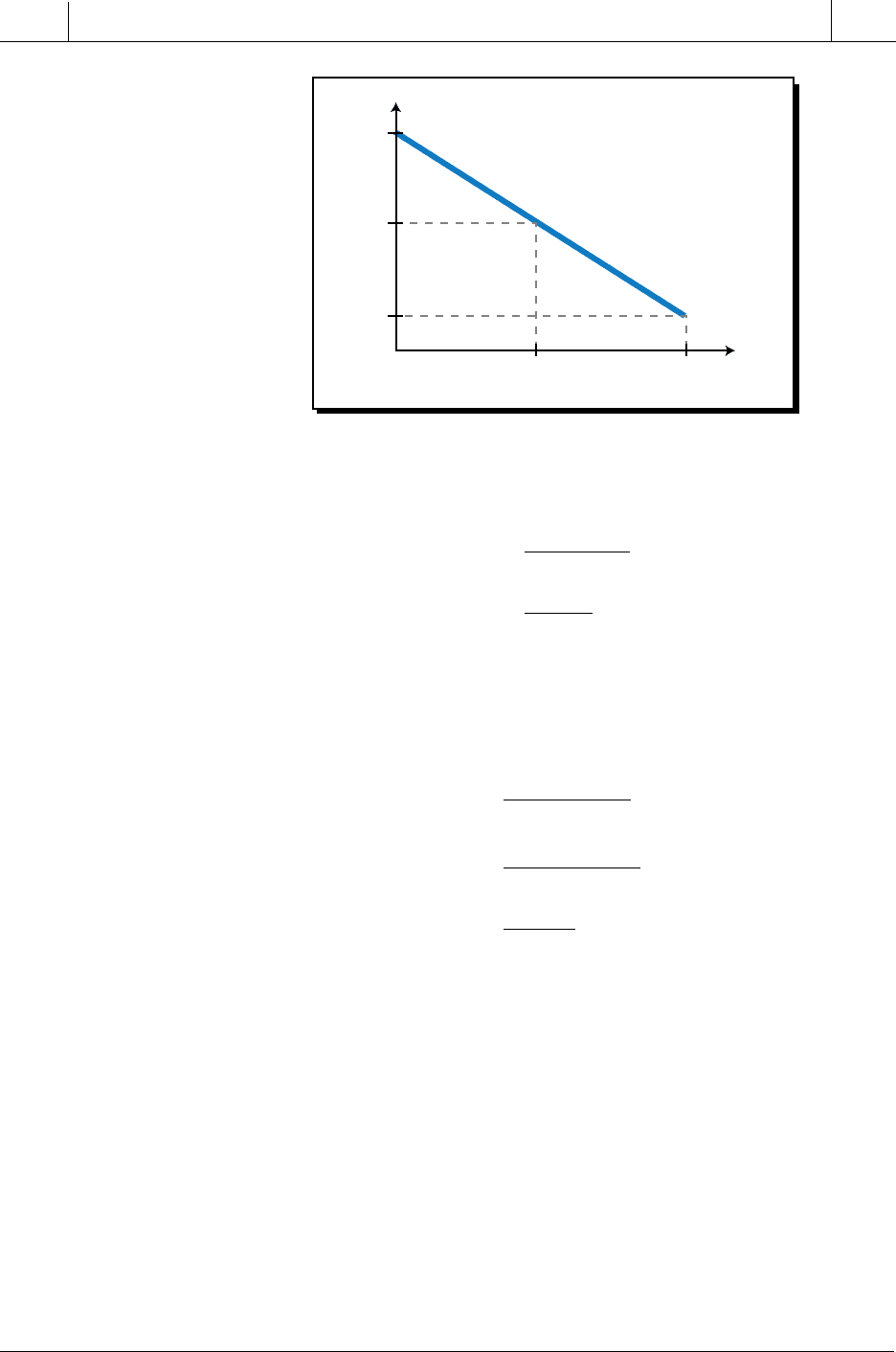
698
SECTION
4
PLC Process
Applications
Industrial Text & Video Company 1-800-752-8398
www.industrialtext.com
CHAPTER
15
Process Controllers
and Loop Tuning
The gain is:
K
PB
P
=
−
=
−
=−
0 100
100
100
1
%%
%
%
%/%
If the process variable temperature is 160°F, the percentage error over the
full variable range will be:
E
SP PV
PV PV
=
−
−
=
°− °
°− °
=
−°
−°
=
min max
%
150 160
100 200
10
100
10
FF
FF
F
F
This indicates that the value of PV is 10% more than the SP value. Assuming
that the previous CV output was at the set point (50%), the controller’s new
output will be:
CV K E CV
Pnew old
=+
=− +
=− +
=
()(%) %
%%
%
110 50
10 50
40
Thus, the controller will reduce the value of its output to 40% of its range. This
will affect the process by reducing the process variable to the set point value.
Figure 15-30. Proportional gain for a reverse-acting controller.
100%
50%
0%
CV
100°F 200°F150°F
E
= 0
K
is negative
P
V
